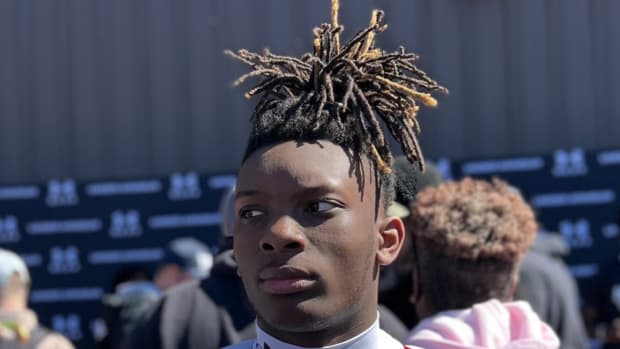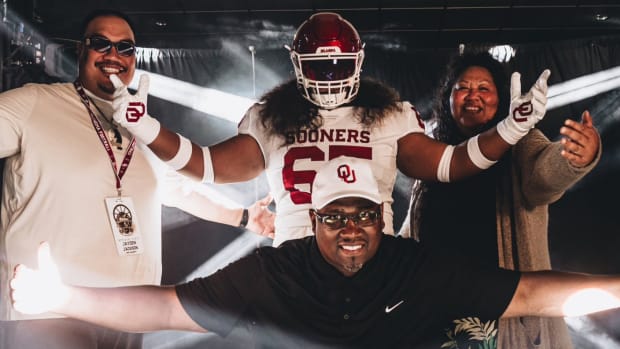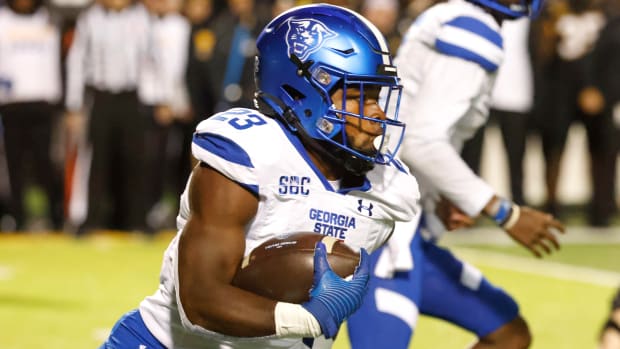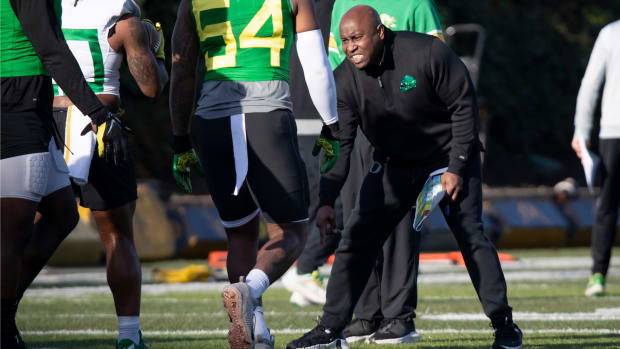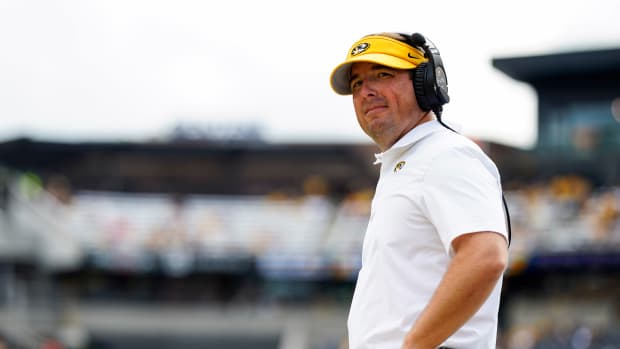Which of last year's disappointments can bounce back in 2016?
Get all of Colin Becht’s columns as soon as they’re published. Download the new Sports Illustrated app (iOS or Android) and personalize your experience by following your favorite teams and SI writers.
Last week we looked at the biggest risers in college football, the teams who improved their win totals by the most in 2015. But we have to take the bad with the good, and for every program that made a big leap up the standings, another crashed down.
The hope for every team that faltered last fall is that it was merely a one-year blip that will be fixed this season and then forgotten. But of course that can’t be the case for every program. Sometimes the problems are more severe than just a lack of luck, and finding solutions requires more than just flipping the calendar.
Eight teams saw their win totals drop by four wins or more last season. We’ll play Buy/Sell/Hold to determine who can make an immediate rebound, who might see incremental improvement and who will be mired in another dismal year.
Arizona State: Sell
There are simply too many unknowns to buy into a quick turnaround for Arizona State, which fell from 10–3 in 2014 to 6–7 last year. Let’s start with the quarterback, a position vacated by Mike Bercovici, who threw for nearly 4,000 yards with 30 touchdowns and nine interceptions last season. The Sun Devils have a three-way race—between last year’s backup, Manny Wilkins, and redshirt freshmen Brady White and Bryce Perkins—that appears anything but settled after the spring.
Regardless of who wins the job under center, Arizona State should execute a run-first offense with Demario Richard and Kalen Ballage (1,751 yards and 11 touchdowns combined). The problem is that those proven backs will be running behind an unproven offensive line that must replace three starters after ranking only 79th in adjusted line yards last season.
And then there is the Sun Devils’ secondary, which returns just one starter after ranking 118th in the country in yards allowed per attempt (8.5) last season. With a schedule that features the pass-heavy attacks of Cal and Washington State plus matchups against rising star passers Josh Rosen and Jake Browning and Oregon’s always challenging offense, a vulnerable pass defense could once again weigh down Arizona State.
Boston College: Buy
After a winless conference campaign in 2015, there’s only room for improvement for the Eagles—or more specifically, the Eagles’ offense. Boston College had one of the best defenses in the country last season but one of the worst offenses, so any progress in the standings will have to stem from offensive growth. A touchdown-less spring game wasn’t a great sign, but that’s hardly surprising given the mismatch. The arrival of Scot Loeffler as offensive coordinator and Kentucky quarterback Patrick Towles’s transfer should pay off with more time for both to settle in. The Eagles should be able to escape the ACC’s basement.
Georgia Tech: Buy
No team fell further or more stunningly than Georgia Tech last season, which dropped from 11–3 to 3–9 despite an upset victory over Florida State. The Yellow Jackets won’t be expected to return to the ACC title game this fall, but they should gain some ground if they can address their issues on defense. Paul Johnson’s squad ranked 120th in the nation in sacks last season and allowed 4.7 yards per carry but returns four starters in the front seven.
• BECHT: How will new ACC coaches fare in debut seasons?
Regardless of any defensive improvement, the offense should be in better shape with a proven backfield executing Johnson’s triple-option offense. Justin Thomas returns once again to spearhead the attack, and he’ll have Marcus Marshall and Clinton Lynch behind him. Former highly touted recruit C.J. Leggett will finally make his debut after redshirting in 2014 and tearing his ACL before the ’15 season.
Maryland: Hold
The Terrapins’ introduction into the Big Ten got off to a strong start with a 7–6 debut, but after a 3–9 campaign their place within the conference hierarchy now looks unclear. Is Maryland going to be a player in the loaded Big Ten East or merely a doormat that helps extend the conference’s cable reach and recruiting efforts?
In 2016, that answer will mostly depend on how the Terrapins take to new offensive coordinator Walt Bell’s up-tempo offense. The players have praised it so far, but Bell must select a quarterback from the five options at his disposal this summer, two of which he didn’t get a chance to evaluate this spring (true freshmen Max Bortenschlager and Tyrell Pigrome).
Missouri: Hold
After back-to-back runs to the SEC Championship Game, the wheels finally fell off the Missouri bandwagon as the Tigers slumped to a 5–7 finish in 2015. To avoid a repeat in ’16, newly promoted head coach Barry Odom will have to get more out of an offense that ranked 125th in yards per play and 127th in points per game last season. With numbers that dismal, some progress has to be expected, particularly from quarterback Drew Lock, who was thrust into the starting role as a true freshman but now will have a full off-season to prepare as the starter. (He has yet to be officially named the starter, but there’s no reason to doubt his status.) Throws like this touchdown bomb from the Tigers’ spring game may not demonstrate a knack for threading the needle, but they at least hint at improved explosiveness. Missouri’s defense was stout last season, ranking third nationally in yards allowed per play, and returns eight starters.
The issue for the Tigers is even if the defense remains fierce and the offense makes small improvements, their division is only getting tougher. The SEC East still pales in comparison to the West, but Georgia, Florida and Tennessee all look like contenders. Missouri also has to travel to LSU for an interdivisional crossover game and takes a trip to West Virginia in Week 1.
Oregon: Buy
No team on this list won more games last year than Oregon, but for a team coming off a run to the national championship game in 2014, last year’s 9–4 finish still represented a significant setback. However, it’s important to note the circumstances of those four losses. In games in which graduate transfer quarterback Vernon Adams Jr. played all or most of the game, the Ducks went 7–1. Their one loss came on the road to Michigan State by three when Adams played through a broken finger that limited him for the next four weeks.
It’s important to note when discussing how different Oregon was with a healthy Adams that he is, of course, gone for 2016. Luckily for the Ducks, they don’t have to rely on Jeff Lockie and Taylor Alie this fall, the two quarterbacks they used in Adams’ absence last season. Dakota Prukop joins the mix from Montana State, giving Oregon another proven option from the FCS ranks. And even if Prukop doesn’t pan out, former four-star recruit Travis Jonsen is poised to step in after redshirting last season. Oregon’s electrifying offense, which returns the Pac-12’s leading rusher, Royce Freeman, never lacks for talent at the skill positions; it simply needs a capable quarterback to distribute the ball to all that talent. The Ducks should have that in ’16.
• STAPLES: #DearAndy, is Mark Helfrich under pressure in 2016?
Oregon’s bigger concern last season was a defense that regressed to 85th in defensive S&P+ and 98th in yards allowed per play. The Ducks also lose elite defensive end DeForest Buckner, who recorded 17 tackles for loss and 10.5 sacks in 2015. But they get a huge upgrade in the instruction of the defense with the hiring of Brady Hoke as defensive coordinator. Though Hoke flopped as Michigan’s head coach, his defenses ranked 14th, 41st, 25th and 46th in yards allowed per play, all significantly better than Oregon’s numbers the last two seasons under Don Pellum, who was demoted to linebackers coach for this season. Hoke’s aggressive style of defense should force more turnovers and three-and-outs, getting the ball back in the hands of the offense quicker.
Rutgers: Sell
Chris Ash may bring stability to a Rutgers program sorely in need of it, but it’ll take more than incremental progress before the Scarlet Knights rise in the standings. Rutgers fell from 8–5 in 2014 to 4–8 last year, including a 1–7 mark in Big Ten play. For now they appear to face a low ceiling due to the strength of the Big Ten East that all but blocks a finish higher than fifth in the division.
The Knights have the pieces to grow, including two productive running backs (Josh Hicks and Robert Martin combined for 5.3 yards per carry last year) and a defense that returns seven starters. But until Ash can upgrade the talent through recruiting, it’s hard to see Rutgers consistently competing with Ohio State, Michigan State, Michigan and Penn State, other than the occasional fluke upset. With four likely divisional losses there, plus challenging matchups at Washington, vs. Iowa and at Minnesota, the path to bowl eligibility is razor thin.
South Carolina: Hold
In his first press conference after being fired at Florida, Will Muschamp defended the caliber of players he left behind, telling reporters, “Don’t let that new guy tell you he ain’t got any players.” The same can’t be said of the South Carolina program Muschamp inherits. The Gamecocks ranked 10th in the SEC in recruiting, according to Scout.com, in 2013, ’14 and ’15. Their 2016 class, a mixture of the efforts of the prior coaching staff and Muschamp’s, ranked 9th in the conference. South Carolina simply isn’t landing the talent to contend in a loaded conference.
Still, that doesn’t mean the Gamecocks won’t improve on last season’s 3–9 mark. Muschamp is a proven defensive mind who brings an immediate boost to a unit that ranked 97th in defensive S&P+ and 98th in yards allowed per play in 2015. Though ineffective last year, the Gamecocks at least retain experience, with eight starters back on defense, including top tackler Skai Moore.
• JOHNSON: Late-arriving Bentley livens up South Carolina QB battle
The offense simply needs stability, as four different quarterbacks attempted passes last season. Muschamp and offensive coordinator Kurt Roper appear to have narrowed down the race to two options, listing Perry Orth and Brandon McIlwain at the top of the post-spring depth chart. Four-star recruit Jake Bentley’s arrival this summer adds a new wrinkle to the competition, but a battle involving two four-stars in Bentley and McIlwain seems likely to pay dividends this fall.

